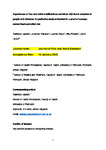Experiences of foot and ankle mobilisations combined with home stretches in people with diabetes: A qualitative study embedded in a proof-of-concept randomised controlled trial
| dc.contributor.author | Lepesis, V | |
| dc.contributor.author | Marsden, Jonathan | |
| dc.contributor.author | Paton, Joanne | |
| dc.contributor.author | Rickard, A | |
| dc.contributor.author | Latour, Jos M | |
| dc.date.accessioned | 2022-01-14T15:54:57Z | |
| dc.date.issued | 2022-01-29 | |
| dc.identifier.issn | 1757-1146 | |
| dc.identifier.issn | 1757-1146 | |
| dc.identifier.other | 7 | |
| dc.identifier.uri | http://hdl.handle.net/10026.1/18558 | |
| dc.description.abstract |
<jats:title>Abstract</jats:title><jats:sec> <jats:title>Background</jats:title> <jats:p>The benefits of exercise and staying active are widely reported in the literature, however adherence and engagement with exercise amongst people with long-term illness and diabetes is poor. Physiotherapy aims to promote independence and physical activity using a range of strategies, including manual therapy and education/advice on exercises. However, low adherence impacts negatively on treatment outcomes. In this study, the practicality of physiotherapy interventions in patients who participate in a proof-of-concept (PoC) randomised controlled trial (RCT) will be considered.</jats:p> </jats:sec><jats:sec> <jats:title>Aim</jats:title> <jats:p>To explore the experiences of people with diabetes who received an intervention package of foot and ankle mobilisations combined with home stretches for a 6-week period.</jats:p> </jats:sec><jats:sec> <jats:title>Design</jats:title> <jats:p>An embedded qualitative study in a proof-of-concept RCT using semi-structured interviews and thematic analysis.</jats:p> </jats:sec><jats:sec> <jats:title>Participants</jats:title> <jats:p>Purposive sample of 16 participants (mean age 73 years) with a diagnosis of diabetes (mean duration 13.4 years) were recruited.</jats:p> </jats:sec><jats:sec> <jats:title>Results</jats:title> <jats:p>Analysis revealed seven themes informing the adherence and non-adherence to the exercise intervention. Themes describing the positive experiences were: 1) support from others to do the exercises; 2) psychological factors to motivate exercise adherence; 2) physical factors contributing to exercise adherence; 4) acceptability of home exercises during and beyond the study. Other themes described barriers: 5) social factors that contributed to exercise disengagement; 6) emotional limitations that influence exercise avoidance; 7) physical circumstances that made exercise participation burdensome. Themes highlighted positive influences by physiotherapists, the motivation of doing exercises while participating in a study, improving the perceived range of motion in their foot and ankle and reducing discomfort in these joints whilst being more active with daily activities.</jats:p> </jats:sec><jats:sec> <jats:title>Conclusion</jats:title> <jats:p>Our findings highlighted that the intervention of foot and ankle mobilisations combined with home stretches is feasible for study participants. Psycho-social support, self-efficacy, and physiotherapy support are motivational to adhere to the study intervention and might contribute to the success of a full-scale RCT.</jats:p> </jats:sec> | |
| dc.format.extent | 7- | |
| dc.format.medium | Electronic | |
| dc.language | en | |
| dc.language.iso | en | |
| dc.publisher | BioMed Central | |
| dc.subject | Diabetes | |
| dc.subject | Physiotherapy | |
| dc.subject | Adherence | |
| dc.subject | Barriers | |
| dc.subject | Exercise | |
| dc.subject | Mobilisations | |
| dc.title | Experiences of foot and ankle mobilisations combined with home stretches in people with diabetes: A qualitative study embedded in a proof-of-concept randomised controlled trial | |
| dc.type | journal-article | |
| dc.type | Journal Article | |
| dc.type | Randomized Controlled Trial | |
| plymouth.author-url | https://www.webofscience.com/api/gateway?GWVersion=2&SrcApp=PARTNER_APP&SrcAuth=LinksAMR&KeyUT=WOS:000748312300001&DestLinkType=FullRecord&DestApp=ALL_WOS&UsrCustomerID=11bb513d99f797142bcfeffcc58ea008 | |
| plymouth.issue | 7 | |
| plymouth.volume | 15 | |
| plymouth.publication-status | Published | |
| plymouth.journal | Journal of Foot and Ankle Research | |
| dc.identifier.doi | 10.1186/s13047-022-00512-z | |
| plymouth.organisational-group | /Plymouth | |
| plymouth.organisational-group | /Plymouth/Faculty of Health | |
| plymouth.organisational-group | /Plymouth/Faculty of Health/School of Health Professions | |
| plymouth.organisational-group | /Plymouth/Faculty of Health/School of Nursing and Midwifery | |
| plymouth.organisational-group | /Plymouth/REF 2021 Researchers by UoA | |
| plymouth.organisational-group | /Plymouth/REF 2021 Researchers by UoA/UoA03 Allied Health Professions, Dentistry, Nursing and Pharmacy | |
| plymouth.organisational-group | /Plymouth/Research Groups | |
| plymouth.organisational-group | /Plymouth/Research Groups/FoH - Applied Parkinson's Research | |
| plymouth.organisational-group | /Plymouth/Research Groups/Institute of Health and Community | |
| plymouth.organisational-group | /Plymouth/Research Groups/Plymouth Institute of Health and Care Research (PIHR) | |
| plymouth.organisational-group | /Plymouth/Users by role | |
| plymouth.organisational-group | /Plymouth/Users by role/Academics | |
| plymouth.organisational-group | /Plymouth/Users by role/Researchers in ResearchFish submission | |
| dc.publisher.place | England | |
| dcterms.dateAccepted | 2022-01-12 | |
| dc.rights.embargodate | 2022-2-16 | |
| dc.identifier.eissn | 1757-1146 | |
| dc.rights.embargoperiod | Not known | |
| rioxxterms.versionofrecord | 10.1186/s13047-022-00512-z | |
| rioxxterms.licenseref.uri | http://www.rioxx.net/licenses/all-rights-reserved | |
| rioxxterms.licenseref.startdate | 2022-01-29 | |
| rioxxterms.type | Journal Article/Review |


